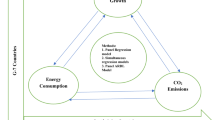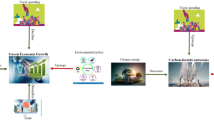Abstract
This study examines the impact of energy demand, air pollution, fossil fuel energy and greenhouse gas emissions on agricultural production in Pakistan for the period 1980–2013. The study utilized the following variables for agricultural production, i.e., agriculture value added, cotton production, wheat production, rice production and sugarcane production in Pakistan. The study employed generalized method of moments estimator to evaluate different simultaneous equations in relation to environmental factors and agricultural production in a country. The results show that CO2 emissions have a positive and energy sources have a negative impact on agricultural value added. The fossil source of energy has a direct relationship with the cotton and sugarcane production, while CO2 emission has a positive relationship with wheat and sugarcane production. Greenhouse gas emissions badly affected the agricultural production including cotton production, wheat production and rice production. Finally, energy consumption exerts the positive impact on the production of cotton, wheat and rice in Pakistan.

Source: Economic Survey of Pakistan (2014)
Similar content being viewed by others
References
Ahmed A (2014) Pakistan’s urban air pollution off the charts: World Bank. Dawn News, July 14th, 2014. www.dawn.com/news/1119031. Accessed 17th Oct 2014
Akhmat G, Zaman K, Shukui T, Malik IA, Begum S, Ahmed A (2014a) A contemporary landscape of air pollution and greenhouse gas emissions leads to inevitable phenomena of low birthweight. Environ Sci Pollut Res 21(15):9408–9414
Akhmat G, Zaman K, Shukui T, Sajjad F, Khan MA, Khan MZ (2014b) The challenges of reducing greenhouse gas emissions and air pollution through energy sources: evidence from a panel of developed countries. Environ Sci Pollut Res 21(12):7425–7435
Akhmat G, Zaman K, Shukui T, Irfan D, Khan MM (2014c) Does energy consumption contribute to environmental pollutants? Evidence from SAARC countries. Environ Sci Pollut Res 21(9):5940–5951
Al Mamun M, Sohag K, Mia MAH, Uddin GS, Ozturk I (2014) Regional differences in the dynamic linkage between CO2 emissions, sectoral output and economic growth. Renew Sustain Energy Rev 38:1–11
Alam A, Malik IA, Abdullah AB, Hassan A, Awan U, Ali G, Naseem I (2015a) Does financial development contribute to SAARC’S energy demand? From energy crisis to energy reforms. Renew Sustain Energy Rev 41:818–829
Alam A, Azam M, Abdullah AB, Malik IA, Khan A, Hamzah TAAT, Zaman K (2015b) Environmental quality indicators and financial development in Malaysia: unity in diversity. Environ Sci Pollut Res 22(11):8392–8404
Al-Mulali U, Ozturk I, Lean HH (2015) The influence of economic growth, urbanization, trade openness, financial development, and renewable energy on pollution in Europe. Nat Hazards 79(1):621–644
Baum CF, Schaffer ME, Stillman S (2003) Instrumental variables and GMM: estimation and testing. Stata J 3(1):1–31
Belloumi M (2014) Investigating the impact of climate change on agricultural production in eastern and southern African countries. AGRODEP working paper 0003
Charles N (2014) Economic impacts of climate change on agriculture and implications for food security in Zimbabwe. Afr J Agric Res 9(11):1001–1007
Costantini V, Martini C (2010) The causality between energy consumption and economic growth: a multi-sectoral analysis using non-stationary cointegrated panel data. Energy Econ 32(3):591–603
Dunkelberg E, Finkbeiner M, Hirschl B (2014) Sugarcane ethanol production in Malawi: measures to optimize the carbon footprint and to avoid indirect emissions. Biomass Bioenergy 71:37–45
Economic Survey of Pakistan (2013) Economic Survey of Pakistan, 2012–2013. Federal Bureau of Statistics, Planning commission wing, Islamabad
Economic Survey of Pakistan (2014) Economic Survey of Pakistan, 2013-14. Federal Bureau of Statistics, Planning commission wing, Islamabad
Faleye T, David J, Dada-Joel OT, Chukwu UC, Ademiluyi YS (2013) Determination of energy consumption in lowland rice production in Nigeria. Int Res J Agric Sci Soil Sci 3(10):336–342
GoP (2014) Economic Survey of Pakistan, Government of Pakistan, Statistics Division, Federal Bureau of Statistics, Islamabad, Pakistan
Harvey CA, Rakotobe ZL, Rao NS, Dave R, Razafimahatratra H, Rabarijohn RH, MacKinnon JL (2014) Extreme vulnerability of smallholder farmers to agricultural risks and climate change in Madagascar. Philos Trans R Soc B Biol Sci 369(1639):20130089
ITC (2011) Cotton and climate change: Impacts and options to mitigate and adapt. In: Technical paper, International Trade Centre, Geneva
Khan M, Damalas CA (2015) Farmers’ willingness to pay for less health risks by pesticide use: a case study from the cotton belt of Punjab, Pakistan. Sci Total Environ 530:297–303
Khan A, Khan MZ, Zaman K, Naz L (2014) Global estimates of energy consumption and greenhouse gas emissions. Renew Sustain Energy Rev 29:336–344
Khwaja MA, Khan SR (2005) Air pollution: key environmental issues in Pakistan. In: Working paper series # 99, Sustainable Development Policy Institute (SDPI), Islamabad, Pakistan
Meyer L, MacDonald S, Kiawu J (2008) Cotton and wool situation and outlook yearbook. Economic Research Service, U.S. Department of Agriculture, Washington
Mudakkar SR, Zaman K, Khan MM, Ahmad M (2013) Energy for economic growth, industrialization, environment and natural resources: living with just enough. Renew Sustain Energy Rev 25:580–595
Ozturk I (2015a) Measuring the impact of energy consumption and air quality indicators on climate change: evidence from the panel of UNFCC classified countries. Environ Sci Pollut Res 22(20):15459–15468
Ozturk I (2015b) Sustainability in the food-energy-water nexus: evidence from BRICS (Brazil, the Russian Federation, India, China, and South Africa) countries. Energy 93:999–1010
Qureshi MI, Rasli AM, Awan U, Ma J, Ali G, Alam A, Zaman K (2015) Environment and air pollution: health services bequeath to grotesque menace. Environ Sci Pollut Res 22(5):3467–3476
Rafindadi AA, Yusof Z, Zaman K, Kyophilavong P, Akhmat G (2014) The relationship between air pollution, fossil fuel energy consumption, and water resources in the panel of selected Asia–Pacific countries. Environ Sci Pollut Res 21(19):11395–11400
Rosenzweig C, Elliott J, Deryng D, Ruane AC, Müller C, Arneth A, Jones JW (2014) Assessing agricultural risks of climate change in the 21st century in a global gridded crop model intercomparison. Proc Natl Acad Sci 111(9):3268–3273
Safa M, Samarasinghe S (2012) CO2 emissions from farm inputs “Case study of wheat production in Canterbury, New Zealand”. Environ Pollut 171:126–132
Sajjad F, Noreen U, Zaman K (2014) Climate change and air pollution jointly creating nightmare for tourism industry. Environ Sci Pollut Res. doi:10.1007/s11356-014-3146-7
Salahuddin M, Gow J, Ozturk I (2015) Is the long-run relationship between economic growth, electricity consumption, carbon dioxide emissions and financial development in Gulf Cooperation Council Countries robust? Renew Sustain Energy Rev 51:317–326
Shahbaz M, Sbia R, Hamdi H, Ozturk I (2014) Economic growth, electricity consumption, urbanization and environmental degradation relationship in United Arab Emirates. Ecol Ind 45:622–631
Smith P, Gregory PJ (2013) Climate change and sustainable food production. Proc Nutr Soc 72(01):21–28
Tahir MU (2014) Air pollution and environment. Pakistan Observer, News, February, 2014. http://pakobserver.net/detailnews.asp?id=232710. Accessed 17th Oct 2014
Tomczak J (2006) Implications of fossil fuel dependence for the food system. Tompkins Country Relocalization Project. http://www.resilience.org/stories/2006-06-11/implications-fossil-fuel-dependence-food-system. Accessed 25th Sept 2014
UN (2001) Our common future, chapter 7: energy: choices for environment and development. UN Documents. http://www.un-documents.net/ocf-07.htm. Accessed 25th Sept 2014
van den Bold M, Kohli N, Gillespie S, Zuberi S, Rajeesh S, Chakraborty B (2015) Is there an enabling environment for nutrition-sensitive agriculture in South Asia? Stakeholder perspectives from India, Bangladesh, and Pakistan. Food Nutr Bull 36(2):231–247
Ward PS, Florax RJ, Flores-Lagunes A (2014) Climate change and agricultural productivity in Sub-Saharan Africa: a spatial sample selection model. Eur RevAgric Econ 41(2):199–226
West TO, Marland G (2003) Net carbon flux from agriculture: carbon emissions, carbon sequestration, crop yield, and land-use change. Biogeochemistry 63(1):73–83
Woods J, Williams A, Hughes JK, Black M, Murphy R (2010) Energy and the food system. Philos Trans R Soc B Biol Sci 365(1554):2991–3006
World Bank (2014) World development indicator. World Bank, Washington
Yuttitham M, Gheewala SH, Chidthaisong A (2011) Carbon footprint of sugar produced from sugarcane in eastern Thailand. J Clean Prod 19(17):2119–2127
Zaman K, Ahmad A, Hamzah TAAT, Yusoff MM (2015a) Environmental factors affecting health indicators in sub-saharan African countries: health is wealth. Soc Indic Res. doi:10.1007/s11205-015-1100-9
Zaman K, Islam T, Rahman ZA, Ghazali AS, Hussain S, Malik MI (2015b) European countries trapped in food poverty and inequality: agricultural sustainability is the promising solution. Soc Indic Res. doi:10.1007/s11205-015-1098-z
Zeb R, Salar L, Awan U, Zaman K, Shahbaz M (2014) Causal links between renewable energy, environmental degradation and economic growth in selected SAARC countries: progress towards green economy. Renew Energy 71:123–132
Zhang YJ, Liu Z, Zhang H, Tan TD (2014) The impact of economic growth, industrial structure and urbanization on carbon emission intensity in China. Nat Hazards 73(2):579–595
Zhang A, Bian R, Li L, Wang X, Zhao Y, Hussain Q, Pan G (2015) Enhanced rice production but greatly reduced carbon emission following biochar amendment in a metal-polluted rice paddy. Environ Sci Pollut Res 22(23):18977–18986
Author information
Authors and Affiliations
Corresponding author
Rights and permissions
About this article
Cite this article
Qureshi, M.I., Awan, U., Arshad, Z. et al. Dynamic linkages among energy consumption, air pollution, greenhouse gas emissions and agricultural production in Pakistan: sustainable agriculture key to policy success. Nat Hazards 84, 367–381 (2016). https://doi.org/10.1007/s11069-016-2423-9
Received:
Accepted:
Published:
Issue Date:
DOI: https://doi.org/10.1007/s11069-016-2423-9






